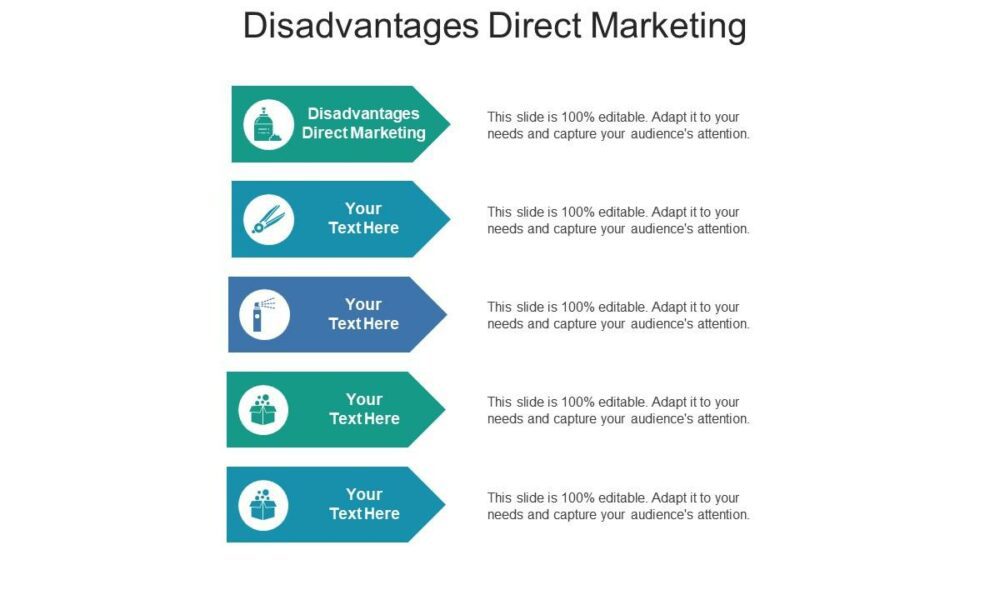What is the most concern disadvantage of direct marketing

They call during dinner. They knock on your door during your favorite TV show. That neatly packaged catalog finds its way straight to the recycling bin.
Direct marketing might be an effective tactic for brands, but it risks seriously annoying consumers.
When brands interrupt people’s day with unsolicited calls, knocks, mailings, or emails, they walk a fine line between promotion and irritation.
And with so much content competing for our attention, intrusive outreach can easily backfire. What may seem like a convenient way to put products in front of customers can feel to consumers like an invasion of privacy and distraction from things they actually care about.
The question then becomes: at what point does direct marketing cross the line? When does it do more harm than good?
The line varies depending on the medium. According to surveys, our tolerance tends to be lowest for phone calls.
Hearing that shrill ring only to be greeted by a sales rep trying to push a product makes most people cringe. Even when screening unknown numbers, the interruption can feel intrusive, especially if calls come frequently.
In contrast, we tend to have a higher threshold for physical mail. Though the waste bothers some, a catalog here or there won’t automatically trigger negative feelings about the sender.
Email sits somewhere in between — easier to ignore than a phone call, but still a source of inbox clutter and information overload if overused for promotional purposes.
Wherever the medium and frequency of outreach, the problem remains the same: marketers focused on their goals rather than the consumer experience.
When the push for profits and growth overshadows respect for people and relationships, it shows. And people are likely to show displeasure by avoiding brands that continuously overstep our boundaries.
But in a metrics-driven culture focused on optimizing response rates, it’s no wonder many still end up pushing too hard.
Until consumer experience takes priority over conversion statistics, the intrusive marketing attempts will continue despite disadvantages and backlash.
Struggling to grow your business? An online marketing agency Coventry can help you reach more qualified customers without annoying marketing!
Direct Marketing Campaigns Can Leave Excessive Environmental Footprints
Besides irritating consumers, some forms of direct marketing also raise environmental concerns.
Leafleting campaigns that blanket neighborhoods with promotional flyers can generate massive paper waste, especially if recipients immediately toss the materials in the recycling bin.
Though recycled paper helps, producing and distributing all of those leaflets still requires resources.
The same goes for lush direct mail catalogs and oversized postcards. With consumers increasingly passionate about sustainability, sending large volumes of paper mail may undermine other eco-friendly initiatives from brands.
Fortunately, digital channels allow for more targeted, eco-friendly outreach. Email marketing only uses virtual resources.
And online ads can be narrowed down to specific demographics likely to have interest.
When physical mail is required, using recycled materials printed locally can help minimize your carbon footprint.
Overall, the best approach is mapping your direct marketing strategy to consumer mindsets.
Mass Outreach Overload Drives Away Consumer Interest
Broadcasting your messaging far and wide might seem like the best approach to increase response rates for your direct marketing campaigns.
However, overly broad outreach often doesn’t work because it annoys the very consumers you want to attract.
Even with response rates of 1-3%, sending blanket emails or catalog mailings can mean 97-99% of recipients toss your message straight in the delete or recycle bin.
Along with wasting resources like paper, postage, and digital storage, you lose future opportunities with disinterested demographics. They’re unlikely to re-engage after receiving bothersome content.
The better path is precision targeting and personalization. Though list sizes will be smaller, you can pinpoint subscriber groups by geography, purchase history, browsing behavior and other attributes indicating real interest. These consumers will be far more receptive to your outreach.
When they open an email, it will contain relevant products, sales and recommendations suited to past interactions.
Direct mail can highlight new releases in categories they’ve purchased before. With context that speaks specifically to them, response rates with targeted groups should meet or exceed broader campaign benchmarks.
And you reduce the risk of turning off new customers with mass messages that offer no real value.
Standing Out from the Mailbox Clutter Is Another Challenge
In the race for consumer attention, direct marketing must compete with an ever-expanding flood of promotional mail, email, catalogs and more.
Even as printing and postage costs rise, the ease of bulk digital communication means household mailboxes remain stuffed to overflowing. Email inboxes also swell, despite filters.
With so many messages and sensory inputs fighting for mind share, what can your business do to stand out from the noise?
How do you stop your beautifully crafted catalog or email blast from becoming just another piece of discarded clutter?
It starts with recognizing direct marketing for what it is – a privilege, not a right. Consumers grant brands access to their personal spaces, whether physical or digital, because they trust businesses not to abuse the opportunity.
When spam filters move your email to the promotions tab, don’t try to trick the system. Respect the tab instead. Craft targeted subject lines clearly highlighting authentic value to those who have opted in.
Use direct mail sparingly, emphasizing quality design and personalization minus oversized formats when printed pieces are warranted.
Essentially, you earn space in already crowded mailboxes and inboxes through relevance and restraint.
If your messages consistently delight target customers with useful ideas tailored just for them, yours will be the letter opened or email clicked amidst the melee of less thoughtful marketers.
Put consumer experience first, and it will set your communications apart.
Cost is the Ever-Present Challenge in Direct Marketing
Direct mail costs can quickly multiply, with expenses spanning creative design, list purchasing, printing, labeling, and postage at scale.
Telemarketing carries high labor costs, with callers required to manually work through contact lists. Both tactics seem financially out of reach for many modest marketing budgets compared to the scalability of digital.
However, writing off direct tactics due to cost alone risks missing their immense potential value. Physical mail and personal calls simply operate differently than digital when it comes to capturing attention and driving action. The question then becomes how to tap into response potential within budget constraints.
The solution lies in rigorous testing and optimization for maximum return on investment. While mass scale direct mail or telemarketing may not be feasible, almost all budgets allow for small, highly-targeted campaigns.
Conduct A/B testing across different list segments, offer variations,Timing, formatting, and personalization levels reveal the combinations delivering the highest response at smallest scale.
Look for outsized returns from niche subgroups before expanding scope.
Telemarketing calls can initially focus on specific high-value existing customers eligible for retention offers saving on new customer acquisition costs.
Direct mail may target localized neighborhoods whose attributes and interests align exceptionally well with your products.
Refine and iterate before gradually expanding campaigns, keeping close tabs on cost per response or conversion to ensure profitability.
The goal is optimizing response thresholds before attempting to scale volume. Technology like call routing tools and targeted digital printing supports lower barriers to entry.
While costs may prevent mass scale deployment, smart direct marketing teams achieve more impact from smaller, more precision campaigns. Initial testing efforts lay the foundation for expanded budgets over time as revenues grow.
Restrictive Data Regulations
Direct marketing relies on contact data to deliver personalized messaging, regulations impose strict limitations around consent and use of private consumer details.
Laws like GDPR and CCPA hand control back to individuals, threatening fines against companies that access, retain or share information without explicit permission.
This directly clashes with longtime marketing norms of purchasing wide data sets and blending various demographic or behavioral profiles to map target groups.
Tactics like scraped email lists or acquiring customer postal details from publishers violate clearly codified consumer rights. Even loosely worded opt-in checkboxes fail the strict consent standards.
The entire direct marketing ecosystem faces reckoning – either reformulate strategy around lawful data sourcing, or accept severely limited prospects.
Tough choices lie ahead around balancing meaningful reach with uncompromising consent standards. There are no easy answers in the evolving privacy era.As a local Coventry SEO solutions provider, SEO No Sweat makes it crazy-easy to get your website ranking. Just reach out for our SECRET SAUCE – our proven mix of keywords, content, and links takes the guesswork out of SEO!




